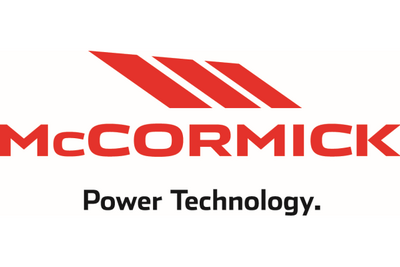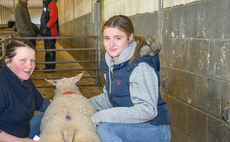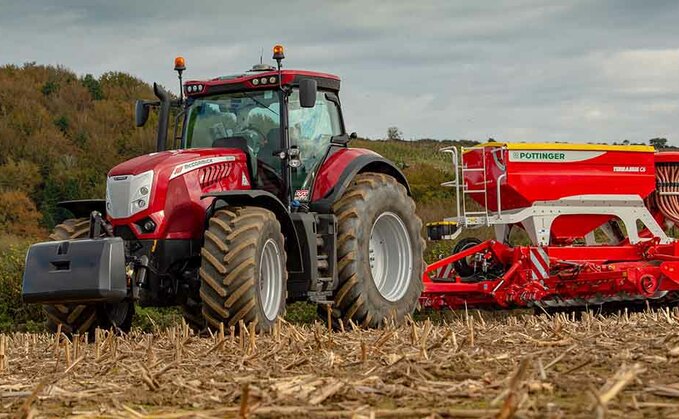
Representing the largest tractors the firm has ever produced, we get behind the wheel of McCormick's newest tractor series, the X8, to find out more.
James Rickard reports...
Designed to satisfy the needs of increasing power demand from its current customers while aiming to attract new ones, McCormick's latest X8 Series signifies more than just an expansion of its tractor range.
This is not McCormick's first effort at producing large tractors, but this latest generation of flagship models represents a renewed step back into farming sectors, particularly crop growing regions, where McCormick has had a minimal presence in recent times.
Made up of three models from 264-310hp (maximum power ratings), the X8 is a culmination of components from a smorgasbord of renowned manufacturers.
These include the use of FPT engines, ZF transmissions and Carraro axles, almost giving the X8 a certain level of automatic kudos. But, is all of this enough to temp potential buyers?
To see what the X8 is made of, we tried out the smallest model, the 264hp X8.660, coupled to a 6m Pottinger Terrasem cultivator drill.
As well as a test of brute force and tractive capabilities in the rolling surroundings of the Somerset countryside, the IsoBus demands of the drill also provided the X8 with something to think about.
ENGINE
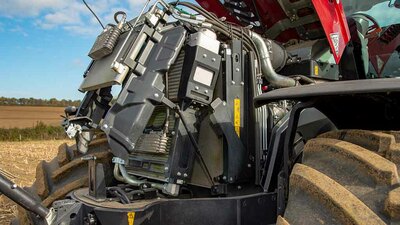
Under the bonnet, the X8 uses the same 6.7-litre FPT engine as its smaller stablemate, the X7.
Likewise, the X8's motor is mounted in a half frame chassis, avoiding any structural loads being transferred through the engine. It also has the positive effect of isolating engine vibration from the cab.
With 264hp on-tap from our test machine, the hilly terrain and challenge of pulling a six-metre cultivator drill tested the motor's capabilities, which despite hanging its tongue out on the steep bits, coped well overall. Torque backup is particularly impressive.
If saving fuel is a priority, then a dial can be used to alter between full power and economy modes. The latter will put more emphasis on the transmission to maintain forward speed, while the former will make the engine work harder to keep up working speeds. An exhaust brake is also standard.
Engine bay access is decent overall, aided by a wide opening bonnet and swing-out cooling packs.
Header tank is clearly visible from the ground, also.
However, getting at the engine oil dipstick is more of a challenge, which, if you want to get at it from ground level, will require a panel removing. If you prefer to leave this panel in place and reach behind it, then a balancing act on top of the diesel tank is your other option, though this is less safe.
We are told McCormick is working on a ‘hatch' to quickly access the dipstick, which will hopefully be available soon - nothing a bit of on-farm workshop wizardry would not cure if you were that inclined.
TRANSMISSION
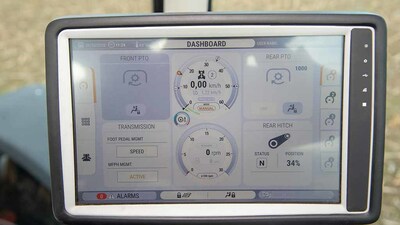
Offering seamless speed adjustment from 0.05-50kph, power in the X8 is channelled to the wheels via a continuously variable transmission (CVT).
Dubbed VT-Drive by McCormick, it is operated in exactly the same way as that of the X7, and the X6 to a certain degree.
Control of forward speed can be made by the main control lever or accelerator pedal, with the tractor deciding ideal ‘revs and ratios' based on operator input.
In addition, the transmission can be operated in one of four ‘virtual' ranges, with the ability to alter the upper limits of the first three ranges.
This is beneficial when you want to operate the tractor at low speeds in pedal mode, with the full range of pedal movement corresponding proportionally to the speed range selected.
While all this sounds very complicated, all transmission characteristics, including its reactiveness, can be easily made through the touch screen terminal.
You can also set a cruise speed in each of the four ranges, simply done either using the physical controls or through the screen.
In all, it is a user friendly transmission. However, a slight quirk is that the tractor will not come to a complete stop, by either coming completely off the accelerator pedal or by using the lever.
Instead the tractor will creep on slightly, requiring the use of the brakes to bring it to a complete stop - much like driving an automatic car. It is no big drama, more a point of difference.
CAB
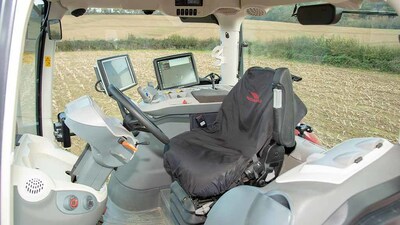
While it is the same size, the X8's cab features a heavier-duty frame than that of the X7, to cope with the weight of the X8 should the worst happen.
Other than that, everything else is pretty much identical.
A four post design and light interior trim offer a pleasant working environment, and the decent all-round views means the tractor does not feel as big as its size suggests.
Pivoting cab suspension does a good job of ironing out the bumps, which can also be adjusted to one of three levels.
In combination with the front axle, it is a comfy tractor.
On the downside, the steps leading up to the cab are a bit shallow to fully get your feet onto them - not good when accessing a tall tractor.
Also, it would be good to see the external door handle positioned lower, so it could be reached from ground level without having to climb the steps first.
In addition, the inside door hand rail could also do with running further down to the door, offering a safer and more convenient rout to your perch.
Once in, though, a logical layout puts all controls to hand, including EasyPilot drive lever, multifunctional and assignable joystick and the standard fitment of the manufacturer's Data Screen Manager (DSM) touch screen terminal.
If anything, it would be good if a master switch could be added to the main console, which could be used to wake up a pre-programmed set of functions such as hydraulics, PTO and auto-steering, for example.
This would compensate for the inconvenience caused by mother regulations, but still retain the desired safety element.
SCREEN TIME
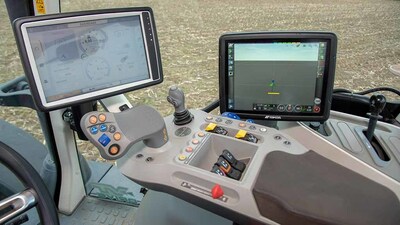
As well as taking care of all tractor setup, DSM looks after IsoBus functions and control.
The clear and clinical approach to its design means navigation is simple, as is the adjustment and setup of the tractor's functions. You can also tailor the screen to show what you want and where.
For our purposes, the screen provided a good sized virtual terminal to operate and setup the drill - some screens can be too small and you end up having to flick through several pages to get to the function/feature you want.
Unfortunately, at this stage, IsoBus functions cannot be assigned to the tractor's various buttons or joystick. However, a third party control interface could be plugged in to accommodate this.
As for automatic steering and guidance, a separate screen is required. While McCormick's official partner for this in the UK is Topcon, supported by LH Agro, the ‘open platform' approach by McCormick means that virtually any guidance system is compatible with the X8's steering valves.
It just means you have two screens in the cab, which is not necessarily a bad thing as it spreads out the information being viewed. In terms of further developments, we would like to see a bolder and brighter dash screen.
Also, on a tractor of this size and specification, would electronically selectable PTO speeds be more appropriate? And finally, how about a decent sized and positioned cup holder?
HYDRAULICS
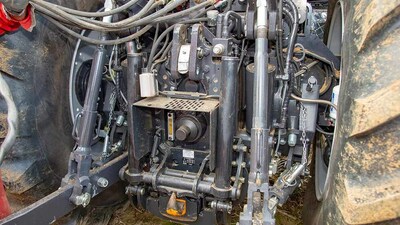
Up to six spools at the rear and three at the front can be specified, along with a diverter valve for functions like the pickup hitch.
Via the tractor's terminal, priority valves can be set, which maintains flow rates for critical pieces of equipment such as a drill's fan, for example.
At the rear of the tractor is fitted a Dromone pickup hitch. Rather than relying on lift rods from the rear linkage, this version uses independent lift cylinders. As a result it requires two, double-acting spools to operate.
Pleasingly, the X8 is fitted with a proper chunky pickup hitch release lever, unlike the toggle as used on the X7s. It also comes with a hydraulic top link as standard.
Alleviating any cross contamination concerns, the transmission and hydraulics use separate reservoirs. Hydraulic oil level checks are done via sensors in the tank, which shows up on the dash, should levels get low, while a sight glass at the rear allows quick checks of transmission oil levels.
However, the hydraulic tank's lid could do with a prop adding to hold it up out of the way when filling.
Front linkage is standard on the X8, which for tillage work will come into its own for attaching ballast.
It is controlled via dedicated spool up front, along with external controls for added convenience.
Two further double-acting spools are available at the front as options, as is an IsoBus socket and a PTO. An external control for one of these spools would be an added bonus.
PRACTICALITIES
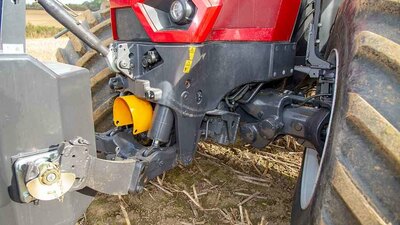
Tool storage sees a compartment incorporated into the top of the diesel tank on the left hand side.
Into this a metal tool box can be slotted, though this could be taken out if you want to make use of the full space provided by the compartment.
Its lockable lid also features a chequer plate design, offering a decent surface to stand on and carry out maintenance. It is a good idea which would could be applied to the lid of the hydraulic tank on the right hand side.
For convenience, link ball storage is provided at the rear. As for drawbar storage, this is under the right hand steps in its own compartment.
While this does keep the mud off it, the screws which fasten the cover on could do with swapping for something which allows quicker and more convenient access to the drawbar.
Providing a level of comfort while helping to get the power down, front axle suspension comes courtesy of Carraro.
But rather than the independent suspension system as used on the X7s, a more heavy-duty solid axle with scissor suspension mechanism is used instead, which also has the upshot of fewer greasing points
The differential can also be 100 per cent locked, and true four wheel braking is delivered via the addition of disc brakes in the front hubs.
In combination with the tractor's sculpted chassis, and the position of the cooling package over the front axle, the steering lock can be kept tight.
FG VERDICT
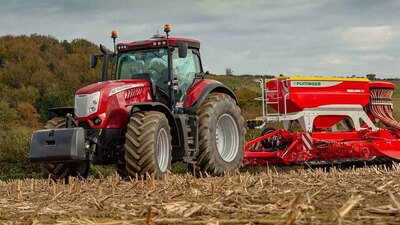
UP to six spools at the rear and three at the front can be specified, along with a diverter valve for functions like the pickup hitch.
Via the tractor's terminal, priority valves can be set, which maintains flow rates for critical pieces of equipment such as a drill's fan, for example.
At the rear of the tractor is fitted a Dromone pickup hitch. Rather than relying on lift rods from the rear linkage, this version uses independent lift cylinders.
As a result, it requires two, double-acting spools to operate. Pleasingly, the X8 is fitted with a proper chunky pickup hitch release lever, unlike the toggle as used on the X7s. It also comes with a hydraulic top link as standard.
Alleviating any cross contamination concerns, the transmission and hydraulics use separate reservoirs.
Hydraulic oil level checks are done via sensors in the tank, which shows up on the dash, should levels get low, while a sight glass at the rear allows quick checks of transmission oil levels.
However, the hydraulic tank's lid could do with a prop adding to hold it up out of the way when filling.
Front linkage is standard on the X8, which for tillage work will come into its own for attaching ballast. It is controlled via dedicated spool up front, along with external controls for added convenience.
Two further double-acting spools are available at the front as options, as is an IsoBus socket and a PTO. An external control for one of these spools would be an added bonus.
Have a look at McCormick's manufacturer account
